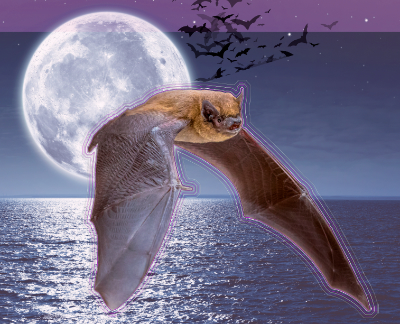Bats ‘see’ the earth’s magnetic field

Echolocation (or SONAR—Sound Navigation and Ranging) is not the only method a bat employs to get its bearings. Like some other animals, migrating bats can make use of the earth’s magnetic field to orientate themselves, including flying over large stretches of featureless ocean. This ability is called magnetoreception, and has been referred to as a sixth sense.1 Tiny particles of magnetic iron oxide (magnetite; Fe3O4) are thought to play a role.2 The mechanism is far from clear, but the cornea, a transparent ‘window’ in front of the iris and pupil of the eye, has been suggested as a possibly significant part of this navigation system in mammals:
“… the cornea ranks among the most densely innervated tissues [supplied with nerves] in the mammalian body, which renders it a promising organ for the search of biological ‘compass needles’.”3
A research project investigated the migrating Nathusius bat (Pipistrellus nathusii) and its sense of direction in long-distance orientation. A team of scientists captured these bats during their migration period over the Baltic Sea. Some of the bat’s eyes had a local anesthetic solution4 applied to desensitize the cornea. They were then released 11 km inland above an open field, in three distinct groups:
Bats with both eyes’ corneas desensitized (bilateral group).
Bats with one eye’s cornea desensitized (unilateral group).
Bats with no eyes’ corneas desensitized (control group).
The unilateral and control groups continued to migrate in the southern direction they were flying before being captured. The bats from the bilateral group flew in random directions.
“This evident difference in behaviour suggests that corneal anesthesia disrupted a sense of direction, yet orientation apparently still works well with one eye.”5

Blind as a bat?
The bat’s vision was not affected. Previous studies had shown that corneal anesthesia of one or both eyes did not make a difference to the bats’ ability to detect light.
Much has been written about the complexity of eyes,6 and evolutionists have been trying hard to provide explanations of how these visual organs gradually developed through a long process of tiny genetic copying mistakes. Now it looks like they have to add yet another function into an already compact space—part of a navigation system involving nerves and likely using a magnetic mineral.
But, thinking in evolutionary terms, how would a half-developed ‘compass’ work? Remember that evolutionists insist that their ‘creation mechanism’ is in no way goal-oriented. Instead, they believe that each small step forward was a completely random happening, ‘chosen’ by natural selection only if it happened to be an improvement on the previous stage. So even a ‘part-way’ compass system would have to be useful in its own right.
This is often described as evolution being ‘blind’. Or, given the increasing wonders of the natural world the deeper we look, does ‘blind’ better apply to the nature of the widespread faith in evolution?
References and notes
- See, Catchpoole, D., Cows: a magnetic sign for evolutionists, 25 Nov 2008; creation.com/cowmag. Return to text.
- Earlier studies of remnant magnetism suggested that in bats these are located somewhere in the head region, but their exact anatomical or intracellular location is unclear. Return to text.
- Lindecke, O. et al., Corneal sensitivity is required for orientation in free-flying migratory bats, Communications Biology 4(522), 2021. Return to text.
- Oxybuprocaine hydrochloride. Return to text.
- Leibniz Institute for Zoo and Wildlife Research, Cryptic sense of orientation of bats localized: The sixth sense of mammals lies in the eye; phys.org, 5 May 2021. Return to text.
- Bergman, J., Did eyes evolve by Darwinian mechanisms? J. Creation 22(2):67–74, Aug 2008; creation.com/eyes-evolve. Return to text.



Readers’ comments
Comments are automatically closed 14 days after publication.